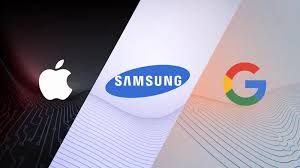The smartphone market is entering an unprecedented era as global tech giants race to launch devices integrated with advanced artificial intelligence (AI) in 2025. From personalized user experiences to predictive features that anticipate needs, AI-powered smartphones promise to redefine how people interact with their devices. The race is heating up as companies like Apple, Samsung, Google, and Huawei introduce models that go beyond conventional performance upgrades, blending software intelligence with cutting-edge hardware to capture the growing demand for smarter technology.
AI in smartphones is no longer just about virtual assistants or camera enhancements. The latest generation of devices leverages machine learning algorithms to predict user behavior, optimize battery life, enhance security, and even provide health monitoring capabilities. For instance, some AI systems can learn users’ daily routines and adjust notifications, app usage, and system settings automatically, creating a seamless experience tailored to individual preferences.
Apple is reportedly preparing its most advanced AI-driven iPhone yet, featuring enhanced predictive text, advanced photography tools, and integration with wearable devices for real-time health analytics. Meanwhile, Samsung is focusing on combining AI with foldable display technology, enabling flexible devices that adapt to multitasking and entertainment needs while optimizing performance based on usage patterns. Google, on the other hand, is leveraging its AI expertise from the cloud to improve on-device intelligence, offering users smarter voice commands, faster app suggestions, and predictive search functionalities.
The push for AI smartphones also reflects broader trends in the technology sector. As chip manufacturers develop more energy-efficient and powerful processors, AI models can now run directly on devices without relying heavily on cloud computation. This not only improves privacy—since sensitive data can remain on the device—but also reduces latency, making interactions faster and more intuitive. Companies are marketing these improvements as major differentiators in an increasingly competitive market.
Consumer expectations are rising rapidly. Recent surveys indicate that over 70% of smartphone users are interested in devices that can anticipate their needs, automate repetitive tasks, and offer smarter photography and security features. AI-driven personalization is becoming a key factor influencing purchasing decisions, especially among younger, tech-savvy demographics who prioritize efficiency, convenience, and innovation.
The camera industry within smartphones is experiencing a revolution thanks to AI. Advanced algorithms can analyze scenes, adjust exposure, and optimize image processing in real time, producing professional-grade photos without manual intervention. Night photography, portrait modes, and even video stabilization have become significantly more sophisticated, making AI a selling point rather than an auxiliary feature.
Security is another domain where AI-powered smartphones are making a mark. Facial recognition, voice authentication, and behavioral biometrics are being enhanced with predictive AI algorithms, making devices less vulnerable to unauthorized access. For corporate users, these features provide additional assurance, particularly as smartphones increasingly serve as portals to sensitive information and cloud-based work platforms.
On the software side, AI-driven apps are becoming smarter, anticipating user needs, suggesting content, and streamlining workflows. Productivity apps, fitness trackers, and entertainment platforms all benefit from AI integration, allowing users to spend less time navigating menus and more time on meaningful engagement. This synergy between hardware and software is positioning AI-powered smartphones as central hubs for personal and professional life.
The global smartphone industry is responding strategically to these developments. Companies are heavily investing in R&D, forming partnerships with AI startups, and expanding AI-focused talent pools. Markets in Asia, North America, and Europe are witnessing an accelerated rollout of AI-enabled devices, while manufacturers are also exploring emerging regions where consumers are eager to adopt next-generation technology.
However, challenges remain. AI-powered devices require sophisticated hardware and software integration, which can increase production costs and device prices. Privacy concerns are also significant, as AI systems rely on collecting and analyzing user data to function effectively. Manufacturers must ensure compliance with data protection regulations while maintaining seamless performance. There is also the question of energy efficiency, as running AI models on devices can consume more battery if not optimized correctly.
The competition is intensifying. Apple’s ecosystem, Samsung’s hardware versatility, Google’s AI expertise, and Huawei’s hardware-software integration are creating a multi-front race that will shape the next generation of smartphones. Analysts predict that by the end of 2025, AI capabilities may become a baseline expectation rather than a premium feature, forcing even mid-tier and budget devices to incorporate intelligent functionalities.
Market analysts are closely watching consumer adoption trends. Early indicators suggest that AI features are influencing not only purchasing decisions but also brand loyalty. Users who experience seamless, intelligent interactions with AI-powered devices are more likely to remain within the same ecosystem, driving long-term revenue streams for manufacturers. This underscores the strategic importance of AI integration beyond immediate device sales.
From an economic perspective, the AI smartphone revolution is expected to drive growth across multiple sectors. Semiconductor manufacturers, app developers, cloud services, and accessory markets all stand to benefit from increased demand for intelligent devices. Additionally, the adoption of AI may spur innovation in adjacent technologies such as AR/VR, IoT devices, and wearable technology, creating a holistic, interconnected ecosystem.
FAQs
What makes an AI-powered smartphone different from a regular one?
AI-powered smartphones leverage machine learning algorithms to predict user behavior, optimize performance, enhance security, and improve photography and app interactions.
Which companies are leading the AI smartphone race?
Apple, Samsung, Google, and Huawei are among the leading companies pushing AI integration in smartphones.
How does AI improve smartphone photography?
AI analyzes scenes in real time, adjusts exposure, optimizes image processing, and stabilizes video, producing professional-quality results.
Are there privacy concerns with AI smartphones?
Yes. AI systems often analyze user data, requiring careful compliance with privacy regulations and secure data handling practices.
Will AI smartphones become standard for all users?
Analysts predict that by the end of 2025, AI capabilities may become a baseline expectation, expanding beyond premium models.
Conclusion
The rise of AI-powered smartphones is transforming the global technology landscape. By combining predictive intelligence, smarter cameras, enhanced security, and optimized performance, these devices are redefining what consumers expect from mobile technology. While challenges such as cost, privacy, and energy efficiency remain, the benefits are compelling, driving a competitive race among major tech companies. As AI becomes a standard feature across devices, the smartphone of 2025 is poised to be more than a communication tool—it is set to become an intelligent personal assistant, professional hub, and gateway to a connected digital ecosystem.






